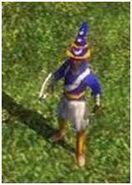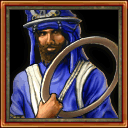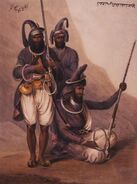Template:Infobox UnitThe Chakram is a Indian native warrior featured in Age of Empires III: The Asian Dynasties. It can be acquired once a Trading Post is built on a Udasi Settlement.
Overview
The Chakram is a Native unit similar to the Grenadier, as it attacks with exploding hoops. The exploding hoop effect is not the hoop exploding, it is the ability of a hoop to ricochet off of shields, armor or even flesh, doing area damage to nearby soldiers.
It can be trained from a Trading Post built on a Udasi Temple site. The temples required can be found on maps around India, such as Deccan and the Himalayas.
They can also be sent from a Home City. They are one of the most powerful native unit, and as they are they are also only archers with splash damage,that makes them are very difficult to counter. If used properly they can wipe out an entire army.
They are also excellent for raiding enemy settlers or villagers, killing several villager or settlers by one hoop.
Shipments
| Click for a list of Chakram related home city cards | ||||||||||||||||||||
|---|---|---|---|---|---|---|---|---|---|---|---|---|---|---|---|---|---|---|---|---|
Indians
|
History
| “ | According to Sanskrit sources, the word “chakra” means circle or wheel. It is linked to the Hindu and Buddhist beliefs of chakra, which relate to centers of energy within the human body. The chakram, named for its resemblance to a wheel, is a circular metal weapon that ranges from 5 to 7 inches in diameter and is of varying thickness. In most cases, it has a sharpened outer edge, and a smooth inner edge by which it is handled. The chakram was usually thrown at its target from a range of 100 to150 feet, although it was also used as a close-combat melee weapon, spun and swung by hand. Soldiers could carry many chakram at one time, often hanging them along the length of their arms or even from a modified turban. From the sixteenth century forward, the chakram was a weapon employed exclusively by Sikh soldiers, who threw them in large volleys like archers fire arrows. Following the Sepoy Mutiny of 1857, also known as the First Indian War of Independence, the English dismantled most Indian armories, and many antique weapons, including chakram, were destroyed and sold as scrap. The twentieth century brought reports of Sikh still using the weapon in battle, with as much skill and accuracy as when it was at its peak. | ” |
| —In-game history section | ||




